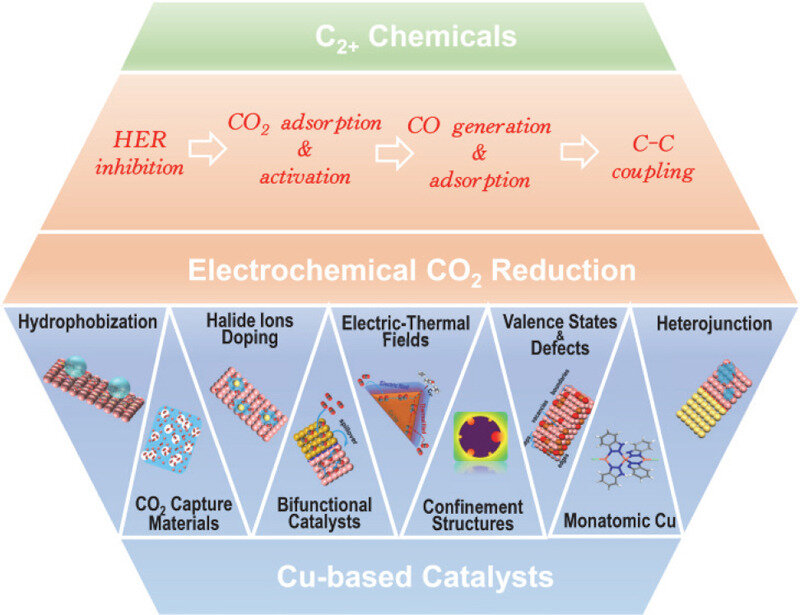The Graphical Abstract emphasizes that the promotion of CO2RR-to-C2+ requires consideration of four important steps: inhibition of HER, CO2 adsorption and activation, CO generation and adsorption, and C–C coupling. To enhance these processes, surface modification of Cu-based electrodes can be achieved through various methods such as hydrophobization, incorporation of CO2 capture materials, doping with halide ions, enhancing electric-thermal fields, and designing bifunctional catalysts, confinement structures, oxidation states, defects, monatomic Cu, and heterojunction structures. This comprehensive review, conducted by Prof. Qun Xu and his research team from Zhengzhou University, China, aims to provide insight into the surface engineering of Cu-based catalysts for efficient CO2RR-to-C2+.
The electrochemical reduction of CO2 to C2+ products is seen as a viable strategy for closing the anthropogenic carbon cycle and increasing economic efficiency. Cu is widely recognized as the most effective active metal for CO2RR-to-C2+ due to its remarkable catalytic performance.
While Cu-based electrocatalysts for CO2RR have been extensively developed, the direct conversion of CO2 to high-value C2+ products with high selectivity and efficiency remains a significant challenge due to complex reaction networks. Achieving precise control over the production of specific C2+ products with high selectivity has been elusive thus far.
There is a need for systematic guiding laws regarding catalyst surface regulation to improve C2+ productivity and gain deeper insights into the CO2RR-to-C2+ reaction mechanism at the surface and/or interfaces. Hence, this comprehensive review addresses the achievements and advancements in surface engineering of Cu-based catalysts, focusing on four crucial steps involved in CO2RR-to-C2+.
Firstly, inhibition of HER can be achieved through surface modification of Cu-based electrodes with organic molecules or specific nanoneedle and hydrophobic porous structures to enhance hydrophobicity and reduce surface wettability.
Secondly, CO2 adsorption and activation can be enhanced through Cu-based catalysts supported by CO2-capture materials or through the introduction of halide ions, which facilitate CO2 activation. The synergistic effect between Cuδ+ and Cu0 in Cu surfaces also aids in CO2 activation.
Thirdly, CO formation and adsorption can be improved by adding foreign components as CO-generation sites or by constructing specific structures that enhance local electric-thermal fields. These modifications efficiently modulate CO coverage, adsorption capacity, and adsorption configurations for C−C coupling.
Lastly, C−C coupling can be promoted through the construction of confinement structures, addition of oxidation states, creation of defects, design of single-atom catalysts, and construction of heterojunction structures. Confinement structures in Cu-based electrodes prolong the retention times of intermediates, while the introduction of positive valence Cu sites, defects, and heterojunction interfaces influence the adsorption behaviors of C1 intermediates and lower the energy barrier of C–C coupling. The ligand groups in single-atom catalysts modulate the C–C coupling path between different C1 intermediates by altering the coordination micro-environment of Cu sites.
Additionally, this work provides valuable insights into the reaction mechanism of CO2RR by understanding the relationship between surface properties of Cu-based catalysts and improved catalytic performances. The review also discusses the current challenges and potential strategies for CO2RR-to-C2+. The research findings have been published in the Chinese Journal of Catalysis. Examples of Cu-Based catalyst advancements are also discussed.
In summary, this comprehensive review highlights the importance of surface engineering in Cu-based catalysts for efficient CO2RR-to-C2+. The four crucial steps involved in CO2RR-to-C2+ are thoroughly addressed, and various strategies for surface modification are discussed. The review provides valuable insights into the mechanisms involved in CO2RR and offers potential strategies and solutions to overcome current challenges.
Denial of responsibility! TechCodex is an automatic aggregator of the all world’s media. In each content, the hyperlink to the primary source is specified. All trademarks belong to their rightful owners, and all materials to their authors. For any complaint, please reach us at – [email protected]. We will take necessary action within 24 hours.

Jessica Irvine is a tech enthusiast specializing in gadgets. From smart home devices to cutting-edge electronics, Jessica explores the world of consumer tech, offering readers comprehensive reviews, hands-on experiences, and expert insights into the coolest and most innovative gadgets on the market.


